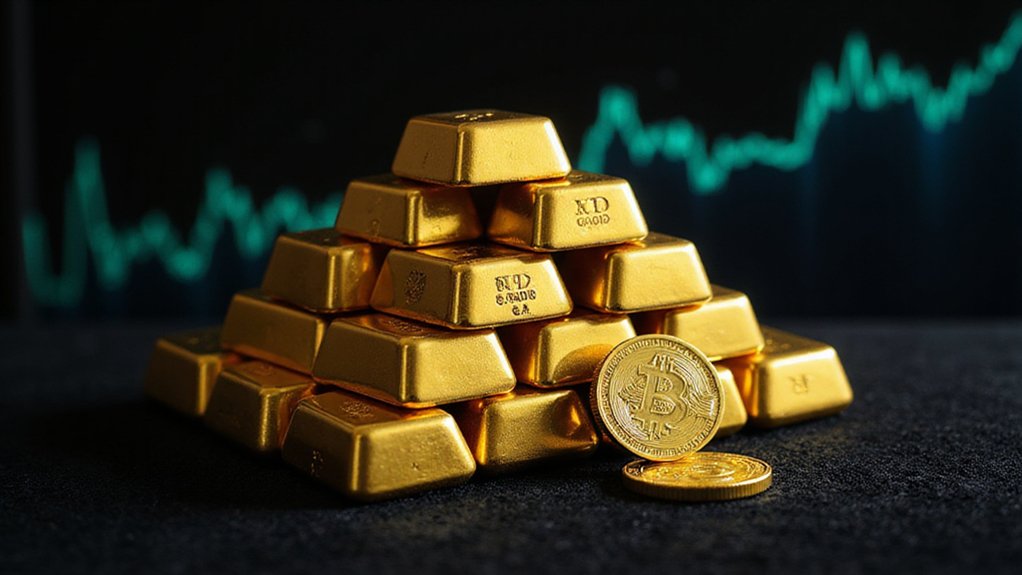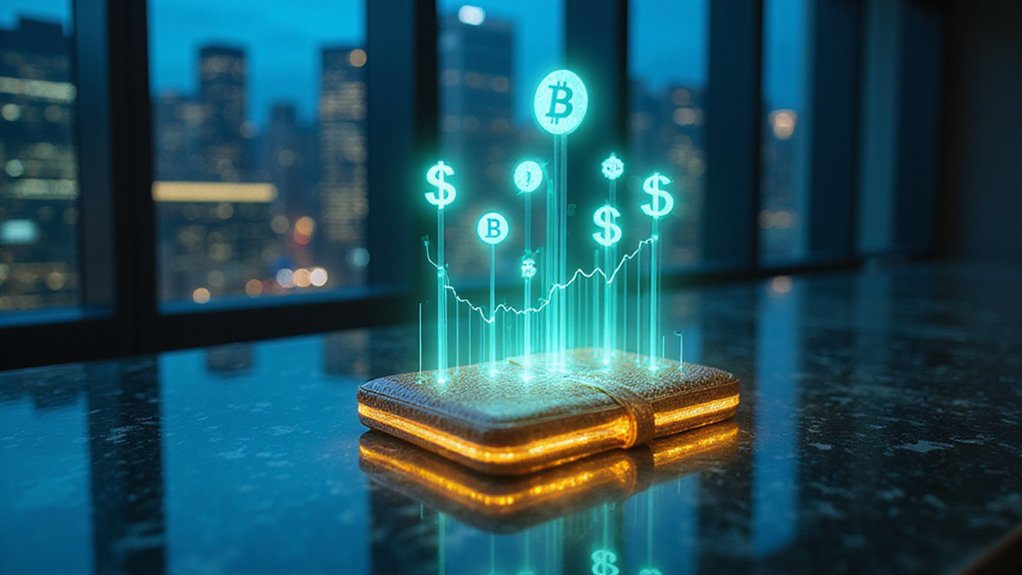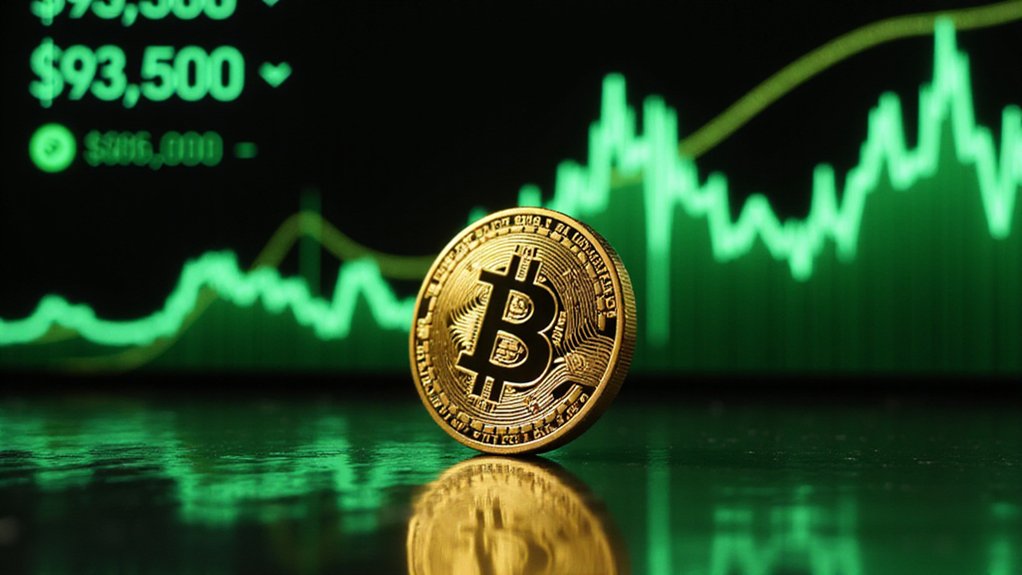Gold’s market capitalization reached $20.8 trillion in March 2025, having surpassed the $20 trillion threshold just one month prior. This extraordinary valuation exceeds the combined GDP of several major economies—all for a metal that produces no yield and would fit in less than two Olympic swimming pools. Central bank acquisitions, strong Asian demand, and geopolitical uncertainties continue driving prices, with J.P. Morgan forecasting potential $3,000 per ounce targets. The ancient store of value’s modern prominence reveals fascinating economic paradoxes.

The staggering $20.8 trillion market capitalization of gold—a figure that quietly surpassed the GDP of several major economies combined—represents one of the most fascinating paradoxes in modern finance.
This milestone, reached in March 2025 after exceeding the $20 trillion threshold just a month earlier, reflects humanity’s enduring obsession with a metal that, unlike most assets, produces no yield yet commands extraordinary value.
The total discovered gold—a mere 272,000 metric tons (less volume than two Olympic swimming pools)—has achieved this valuation through a combination of scarcity, historical significance, and our apparently unshakable confidence in its worth.
Production figures reveal the methodical pace at which this precious metal enters circulation: 3,670 metric tons extracted in 2024, supplemented by 1,370 metric tons from recycling efforts.
With approximately 217,000 metric tons already produced throughout human history and only 55,000 metric tons remaining in accessible reserves, gold’s finite nature undergirds its persistent value proposition.
The price trajectory has been remarkably bullish, reaching an unprecedented $2,936.85 per ounce on February 19, 2025—a figure that would have seemed implausible to analysts just a few years prior.
This remarkable valuation stems from a convergence of factors that show no signs of abating.
Central banks continue their acquisitive behavior, while consumer demand (particularly from the economic powerhouses of India and China) maintains upward pressure on prices.
Geopolitical uncertainties—those reliable companions of financial markets—further bolster gold’s status as the proverbial safe harbor in turbulent seas.
Despite the resilient US dollar (typically an inverse correlate of gold prices), forecasts from institutions like J.P. Morgan suggest the possibility of prices reaching $3,000 per ounce before year’s end.
Sustainable practices in the industry are gaining momentum, with recycled gold sources contributing significantly to the overall supply chain and helping meet the growing demand without further depleting underground reserves.
The bullish sentiment is particularly evident as gold continues to perform well in both falling or rising U.S. yield environments, demonstrating its versatility as an investment during various economic conditions.
The perceived value calculation for gold follows the same principle as company stocks, multiplying quantity by current price to determine total market worth.
The irony remains that gold’s market capitalization—a number that exceeds the combined value of many Fortune 500 companies—rests on a commodity whose practical applications represent a fraction of its perceived worth.
Yet as economic indicators fluctuate and monetary policies evolve, this ancient store of value continues its improbable ascent in our thoroughly modern markets.
Frequently Asked Questions
How Does Gold’s Market Cap Compare to Bitcoin?
Gold’s market capitalization dwarfs Bitcoin’s by an order of magnitude—approximately $20.8 trillion versus less than $1 trillion in early 2025.
This disparity reflects gold’s established role as a physical store of value with industrial applications, compared to Bitcoin’s youth as a speculative digital asset.
While both respond to geopolitical tensions, gold enjoys relative stability whereas Bitcoin exhibits notorious volatility.
Regulatory changes particularly impact Bitcoin, while gold—immune to such digital-age vicissitudes—maintains its millennia-old gravitational pull on investor capital.
Can Individual Investors Impact Gold’s Market Cap?
Individual investors exert minimal influence on gold’s market cap, their collective impact dwarfed by institutional giants and central banks who routinely add 1,000+ metric tons annually.
While retail participation through physical bullion, ETFs, and derivatives creates localized price volatility, these ripples barely disturb the $20.8 trillion ocean.
Even coordinated social media-driven movements (reminiscent of meme stock phenomena) merely produce ephemeral price fluctuations without altering the fundamental supply-demand equation that governs gold’s valuation.
Do Central Bank Gold Reserves Affect Market Capitalization?
Central bank gold reserves greatly influence market capitalization through multiple mechanisms.
Holding approximately 34,000 metric tonnes collectively (a substantial portion of above-ground gold), central banks create baseline demand that underpins valuation.
Their purchasing activities—often interpreted as confidence signals—can drive prices upward, while sales may exert downward pressure.
During economic uncertainty, increased central bank acquisitions typically boost market capitalization, as these institutions leverage gold’s unique status as a hedge against inflation and currency devaluation.
How Often Is Gold’s Market Cap Recalculated?
Gold’s market cap undergoes constant recalculation—a perpetual dance of numbers responding to market forces.
While price fluctuations trigger near-continuous reassessments during global trading hours, the supply variable changes more glacially.
Financial platforms update these calculations in real-time as gold prices shift, though thorough recalibrations that incorporate revised above-ground supply estimates occur less frequently—typically when organizations like the World Gold Council release updated data on global reserves.
What Factors Could Dramatically Reduce Gold’s Market Value?
Several factors could dramatically reduce gold’s market value.
A strengthening dollar (gold’s perennial nemesis) alongside economic stability diminishes its safe-haven appeal, while persistent low inflation undermines its hedge status.
Technological breakthroughs in mining or recycling might flood markets with supply, and central bank selling would exacerbate downward pressure.
Perhaps most consequentially, rising real interest rates make this non-yielding asset increasingly unattractive, while cryptocurrency adoption—the digital usurper—threatens gold’s traditional store-of-value proposition in our increasingly dematerialized financial ecosystem.









